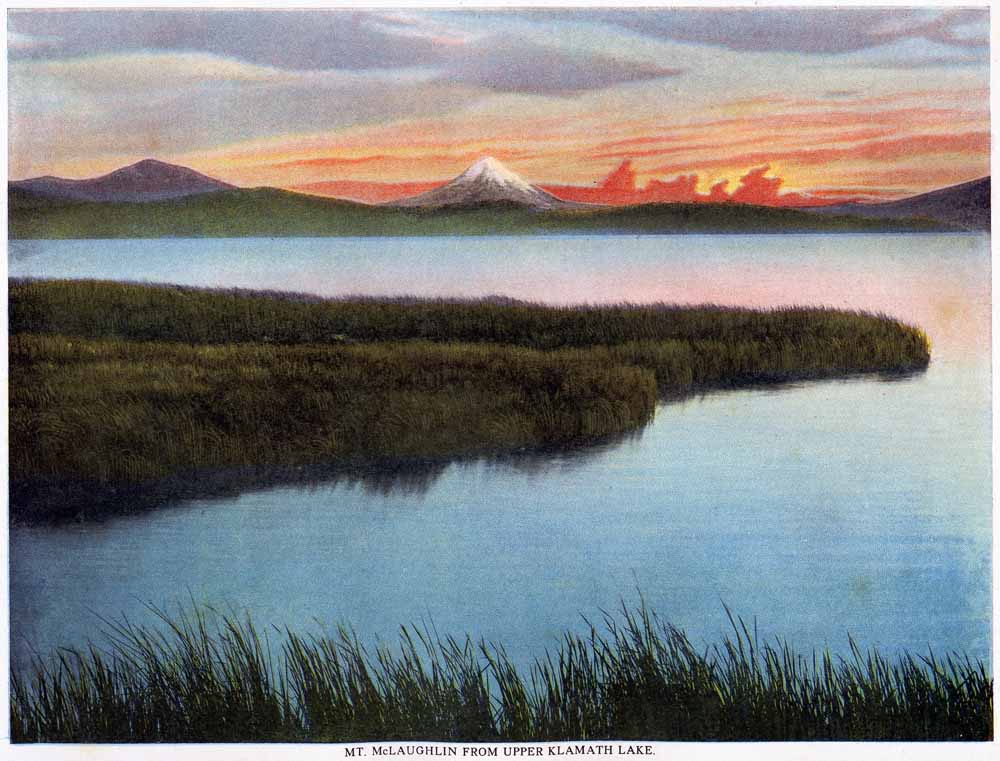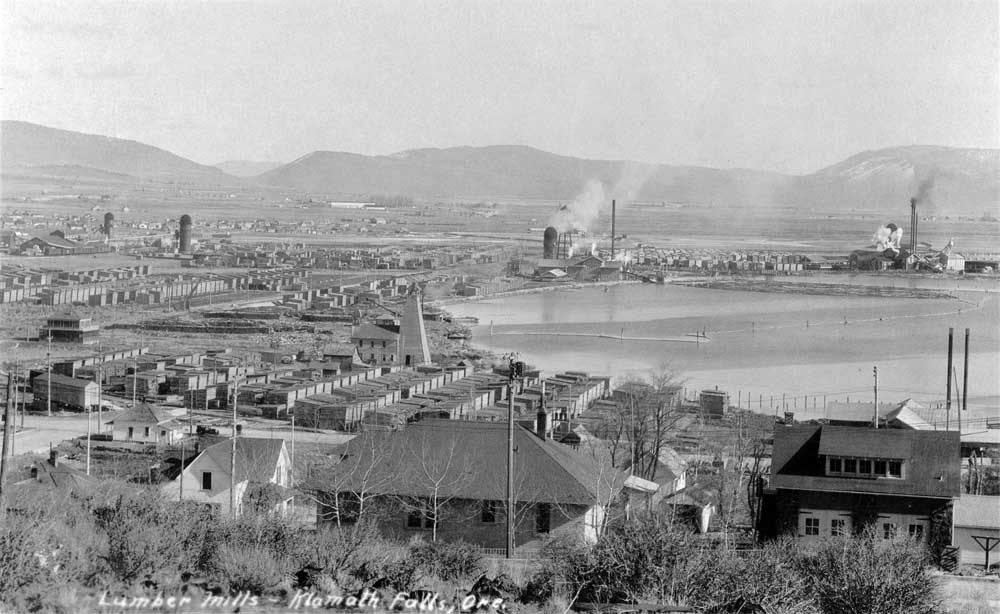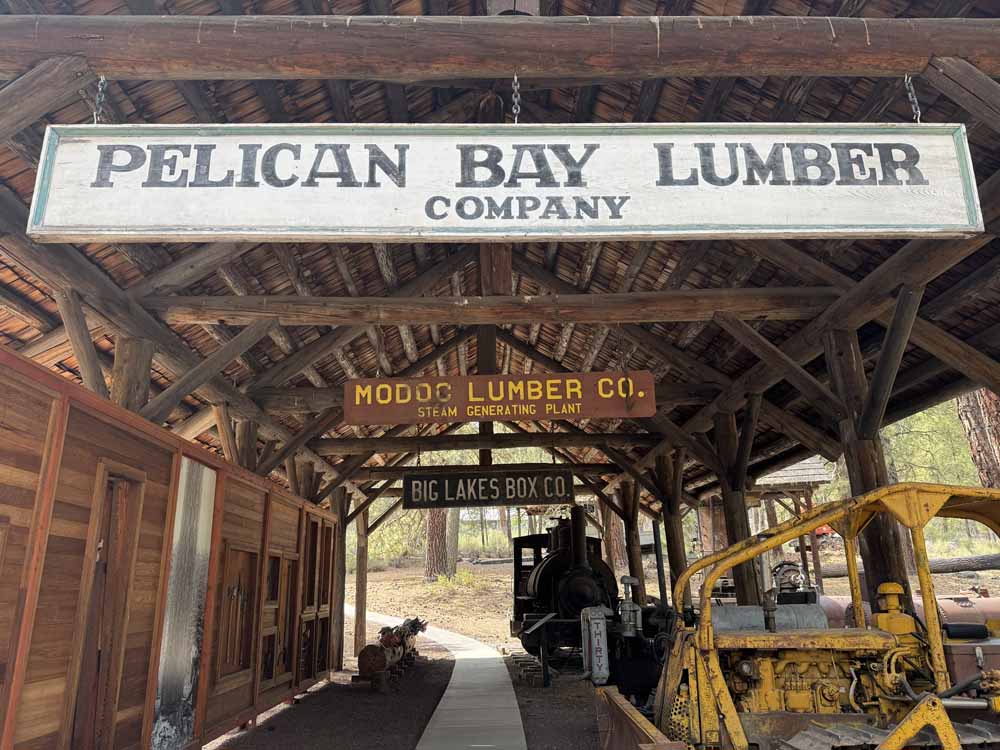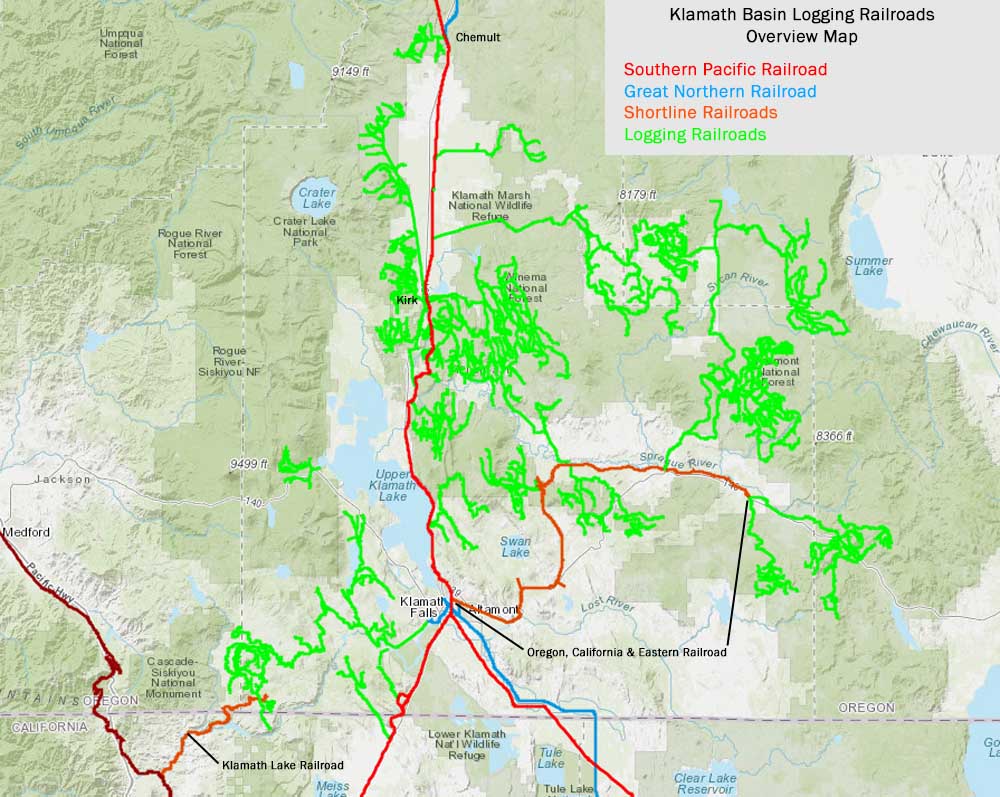|
Klamath Basin Logging Railroads |
|
|
 |
|
Klamath Lake from Southern Pacific's The Shasta Route- Along the Road of a Thousand Wonders
|
|
|
The mountains rising in all directions from Klamath Lake support vast stands of forests dominated mostly by Ponderosa Pine, Sugar Pine, Douglas Fir, and a few other important commercial species. The remote location limited early commercial logging of the area, along with the amount of overall private ownership. The majority of the best timber stands in the Klamath basin ended up on lands included into the Klamath Indian Reservation as established by the Treaty of 1864 that set the area aside for the combined Klamath, Modoc, and Yahooskin tribes. Most of the surrounding country later got included into National Forests upon their establishment in the early 1900s. Initially, the largest blocks of private land was a land grant totalling 845,536 acres stratching from the Willamette Valley to the Owyhee River in southeast Oregon that the U.S. Congress awarded on 4 July 1866 to the Oregon Central Military Wagon Road. This grant awarded 100,000 acres or so within the reservation boundary to the road, which later on became the subject of substantial litgation between the various involved parties that eventually resulted in a settlement under which the Oregon Land and Livestock Company, successor interest to the wagon road company, deeded those lands back in exchange for a solid 87,000 acre block of prime timberland in the Yamsay Mountain area, which the company later sold to Long-Bell Lumber Company. Commercial logging above and beyond that needed to meet local needs started in the mountains on the southwest fringe of the basin, where the Klamath River was used to float logs down to the original Central Pacific/Southern Pacific main line connecting Oregon and California. The situation started to change when the Klamath Lake Railroad completed its line into Pokegama in 1903, though getting to the railhead required a thiry mile wagon ride over the rough roads going into the mountains southwest of the city. Klamath Falls finally is reported to have offered a $100,000 bonus to the first railroad to reach the community, which prompted several carriers in the region to start building lines towards the city. The Southern Pacific ultimately won the race when its subsidiary California & Northeastern completed a new line running from its existing main line connecting Oregon and California at Weed, California, into the burgeoning city in 1909. As noted on the Harriman's Cross-State Railroad page of this website, this was intended to be the start of a new north-south main line running along the eastern flank of the Cascades, but construction stalled out at Kirk, forty miles north of the city, in 1912. While the railhead remained stalled out at Kirk until 1923 and the new through line to Eugene would not be completed until 1926, the existing railroad allowed for large scale commercial exploitation of the forests to begin. Almost as soon as the railroad opened for business capitalists started building new sawmills in Klamath Falls and other points along the new railroad, with the overwhelming majoriy of logs coming off of timber sales on the Klamath Indian Reservation. Klamath Lake itself served as the primary log delivery method for most of these early operations, as loggers would use horses or other animal power to skid logs directly down to the shores of the lake, then raft them to the mills. The very nature of that kind of logging would only extend so far back into the woods, however, and before long the lumbermen started laying out logging railroads into the woods, some directly from the shores of the lake and others from the Southern Pacific line to Kirk. The construction of the Oregon, California & Eastern to the east of the city followed by the arrival of the Great Northern opened up additional lands that could be harvested plus new markets for the lumber products. The real glory years of the logging railroad in the Klamath Basin lasted from the time the Southern Pacific arrived up until the closing years of World War II, when many sawmills closed for want of any further trees to cut and those that remained turned to trucks to haul logs out of the smaller logging operations that replaced the landscape level clearcutting made possible by the advent of the logging railroad. Pine lumber is especially adept at making shipping boxes, and a large amount of the output from the Klamath country went for use in boxes, mostly for the California and later Oregon citrus and other agriculture product industries. The one survivor in the basin was the massive operations of the Weyerhaeuser Timber Company, which are featured on the Oregon, California & Eastern section of this site. |
|
|
 |
|
Several sawmills can be seen in this partial postcard view of Klamath Falls. Visible operations include portions of the Ackley Brothers Lumber in the middle of the photo and Big Lakes Box Company to the right.
Jeff Moore collection.
|
|
|
 |
|
Signs from several of the large Klamath Basin operations on display at the Collier Logging Museum. Jeff Moore photo.
|
|
|
 |
|
Map showing the extent of the logging railroads built in the Klamath area. In many cases, these maps
only show the main and some branch lines contructed, almost all of these operations had numerous temporary
spurs built into the cutting areas that are generally not shown on this or any of the other maps in this section.
|
|
|
|
Following are links to pages on the companies known to have built and/or operated logging railroads in the Klamath Basin and surrounding
mountains, excluding the Weyerhaeuser operations which as noted are covered in the Oregon, California & Eastern section.
These pages do not include logging or lumber companies that loaded logs only at short spurs or sidings built on the common carrier railroads
or otherwise shipped logs in by rail from elsewhere. Many of these companies built logging railroads at multiple locations through the
years, and some railroads built were operated by more than one company over time. Each link will open in a new window, simply close that
window to return to this page. Algoma Lumber Company Big Lakes Box Company Braymill White Pine Lumber Company/Oshkosh Timber Company Chiloquin Lumber Company Crater Lake Lumber/Crater Lake Box & Lumber/Lorenz Lumber Companies Ewauna Box Company Kesterson Lumber Company Klamath River Lumber Company/Pokegama Sugar Pine/Potters Mill/Klamath Lake Railroad Lamm Lumber Company Modoc /Forest Lumber Companies Pelican Bay Lumber Company Shaw-Bertram Lumber Company Others- Ackley, Nine Brothers, and Wheeler-Olmstead Lumber Companies |
|
|
|
Principle reference for materials in this section is the fine book Railroad Logging in the Klamath Country, written by Jack Bowden
and published by Oso Publishing Company in 2003. The book has been out of print for years, though copies are still readily available on the
used book market. This site only barely skims this subject, I cannot recommend finding a copy of the book for anyone who is interested and
doesn't yet have one. Other principle resources consulted in preparing this page are as follows: - Logging Railroas of the West by Kramer Adams, published 1961 by Bonanza Books. -The Heisler Locomotive, 1891-1941, anonymously written and published 1982 by F.G. Kline, Jr. -The Shay Locomotive, An Illustrated History by Richard A. Henderson, John C. Benson, Geroge R. Kadelak, and Steve Hauff, published 2021 by White River Publishing. -The Willamette Locomotive by Steve Hauff and Jim Gertz, published 1977 by Binford & Mort. - Various issues of The Western Railroader and Klamath Echos One final note about maps, most of the ones in this section are based on the maps in Bowden's book, with locations corrected to visible grades or roads likely converted from railroad grades that are visible in aerial imagery. Some lines are drawn in the approximate locations based on township/range/section or topography. Bowden and a few fellow researchers invested a lifetime exploring and mapping logging railroad grades throughout southern Oregon and northern California, and this work is not meant in any way, shape, or form to replace what they accomplished.  |
|
|